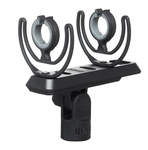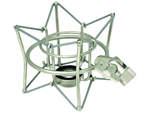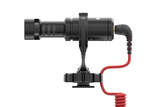JZI|7 is a shock-mount for BT201 and BT301 series microphones. As JZI|7has amazing damping characteristics, it is highly recommended for any pencil type microphone which has similar thickness (24mm) with BT201 and BT301 series microphones. JZI|7 are made by Rycote specially for JZ Microphones.
The design of the shape allows a specific compliance to the microphone, and prevents the handling noise from reaching the capsule. The JZI|7 retains all the flexibility, balance and professional performance that you can expect from a Rycote microphone suspension.
Lyre Suspension
Technical Notes
Microphones are almost as efficient at detecting acceleration as they are at picking up audio, so suspensions aim to allow a capsule to stay still while the support moves. Obviously, if that happened for extreme low frequencies or vast movements it would be impossible to swing a mic on a boom, so suspensions only isolate down to a particular frequency and are optimised for amplitudes in the vibration and minor shock range.
Suspensions all use a springy arrangement that allows the microphone to be displaced, and then exerts a restoring force to return it to the rest point. It will inevitably overshoot and bounce around, but the system should be damped to minimise this. Physics tells us that as the frequency drops the displacement wavelength increases – the suspension has to move further to do as good a job. It also tells us that for any particular mass of microphone and compliance (wobbliness) of suspension there will be a low frequency point at which resonance occurs. At this point the suspension amplifies movement rather than suppresses it; not until about three times the resonant frequency does the system start to isolate properly.
The axis along which a microphone diaphragm moves is the one most sensitive to disturbances. This means that ideal suspensions are most compliant along this (Z) axis but should give firmer control on the horizontal (X) and vertical (Y) axes to stop the mic slopping around.
Diaphragm and ‘donut’ suspensions can work well, but tend to have acoustically solid structures that affect the microphone’s polar response. Silicone rubber bands, shock-cord cat’s cradles, and metal springs are thinner and more acoustically transparent, but struggle to maintain a low tension (and therefore a low resonant frequency) at the same time as providing good X-Y control and reliable damping. The restraining force also rises very steeply with displacement, which limits LF performance.
X, Y and Z
The Rycote ‘lyre’ webs rely primarily on their shape to give different performance on each axis. Typically, a 100g force will barely move a microphone 1mm along the (up and down) Y axis, whereas it will move about four times that on the (sideways) X axis. In the critical Z axis, it will move something like 10 times as far. With a very low inherent tension the resonant frequency can be very low too, and the Z displacement can be vast. Even with small-mass compact microphones, a resonance of <8Hz is possible, which means that microphones can be well-isolated across almost their entire frequency range.
Damping has to be added to metal spring suspensions, and although integral to rubber band versions, is not very easy to control. With the lyre webs damping can be selected almost independently by choosing a suitable plastic. The Hytrel that Rycote uses not only damps smoothly but maintains its characteristics even down to arctic temperatures. It also has a ‘shape memory’ that allows it to be tied in eye-watering knots without developing a permanent ‘set’ – or snapping!
Plotting
Most suspension systems are difficult to ‘scale.’ Springs and elastic bands become thin and fragile, and the range of softness for rubber and foam is limited. However this does not apply to lyre webs. The tiny InVision suspensions, which are visually unobtrusive, isolate compact and similar sized microphones down to <30Hz, yet are tough enough to be dropped on the floor without risk. A research version has even been built for cigarette-sized microphones using 25mm wide webs but without sacrificing performance.
| Kart ismi | Tek çekim | 3 Taksit | 6 Taksit | 9 Taksit |
|---|---|---|---|---|
 |
322,85 | 322,85 (107,62 x 3) |
322,85 (53,81 x 6) |
322,85 (35,87 x 9) |
 |
322,85 | 323,72 (107,91 x 3) |
324,53 (54,09 x 6) |
329,27 (36,59 x 9) |
 |
322,85 | 326,98 (108,99 x 3) |
331,11 (55,19 x 6) |
326,56 (36,28 x 9) |
 |
322,85 | 331,92 (110,64 x 3) |
331,73 (55,29 x 6) |
333,05 (37,01 x 9) |
 |
322,85 | 331,92 (110,64 x 3) |
331,73 (55,29 x 6) |
333,05 (37,01 x 9) |
 |
322,85 | 331,92 (110,64 x 3) |
331,73 (55,29 x 6) |
333,05 (37,01 x 9) |
 |
322,85 | 331,92 (110,64 x 3) |
331,73 (55,29 x 6) |
333,05 (37,01 x 9) |





